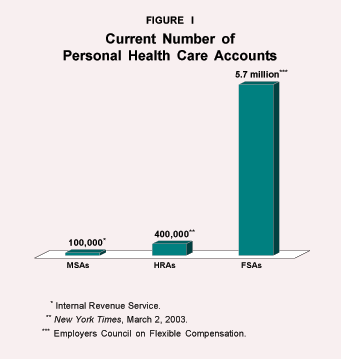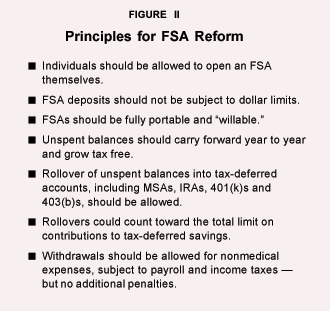Congress can help control health care costs, reduce the number of uninsured and promote quality medical care by making an existing health benefit – Flexible Spending Accounts (FSAs) – more flexible, portable and widely available. Doing so would give millions of Americans more control over their medical care and make them more cost-conscious patients.
Federal law allows employers to create FSAs for their employees. Once a year, employees choose how much pretax income will be deducted from their paychecks and deposited into their FSA. (Employers also may contribute to FSAs, although few do.) Throughout the year, those funds can be spent on medical care at the employee's discretion. Workers can choose their own doctors and are subject to no managed care controls. At the end of the year, however, they lose any unused funds. This use-it-or-lose-it provision guarantees wasteful end-of-year spending on unnecessary medical items. If FSAs were portable and governed by a use-it-or-save-it rule, they could become a powerful force for improving our health care system.
FSAs vs. MSAs and HRAs.
FSAs have much in common with Medical Savings Accounts (MSAs) and Health Reimbursement Arrangements (HRAs): All three give patients access to funds to spend at their discretion on out-of-pocket costs. Yet each is imperfect in its own way. While HRAs allow unspent funds to carry forward into future years, employees do not really own these funds. Instead, HRAs are essentially expense accounts with use-it-or-lose-it incentives similar to FSAs. In contrast, MSAs create an actual savings account that belongs to the worker, follows him or her from job to job, and can be passed on to descendants. However, current law places severe restrictions on who can have an MSA and how much they can contribute.
Of the three, FSAs could have the most immediate positive impact on the health care system. According to the Employers Council on Flexible Compensation, more than 20 million Americans have access to an FSA, though only about 6 million opt for one. In addition, millions of federal employees will be able to open an FSA for the first time this year. This dwarfs both the MSA pilot program, which at last count had sold only about 100,000 policies, as well as the 400,000 HRAs known to exist. See Figure 1.
To make FSAs more widely available, Congress should consider several reforms. See Figure 2.
Needed Reform: Portability.
Currently, workers forfeit unspent FSA balances at the end of the year or when they leave their job. In contrast, an MSA follows the employee from job to job, just like any other savings account. Like MSAs, FSAs should be completely portable.
Needed Reform: Ownership.
Although FSA deposits are made from the employee's paycheck, employees do not really own their FSAs. Not only is the account balance forfeited at year's end or with a change in jobs, the employee's heirs are not entitled to the funds in case of a premature death. These restrictions need to be changed. 
Needed Reform: Carry-Forward Option.
Today, FSA holders forfeit any funds they do not spend by the end of the year. In contrast, MSA holders get to keep what they do not spend, and deposits grow tax free. Like MSAs, unspent FSA balances should carry forward from year to year and grow tax free. This would encourage more prudent consumption of health care resources.
Needed Reform: Rollover Options.
Employees also should have other options for saving unspent FSA balances. They should be able to roll over accumulated balances into other tax-deferred accounts, including MSAs, IRAs, 401(k)s and 403(b)s.
Needed Reform: No Limit Contributions.
Certain proposals before Congress would limit the FSA funds that could be carried forward from year to year. The limit is unnecessary and unwise. At a minimum, the law should be as generous with FSAs as it is with MSAs. A better approach is to remove all limits.
Possible Reform: Count FSA Roll-overs Toward the Limit on Total Additions to Tax-Deferred Savings.
Some fear that FSAs and MSAs could become vehicles for wealthy people to shelter more income from taxation. But the way to respond to that concern is to include FSA rollover amounts in the limit on total contributions to tax-deferred savings rather than the amount that is allocated to health.
Congress has set limits on how much individuals can add to tax-deferred savings each year. Individuals should be able to rollover any FSA balance, so long as their total additions to tax-deferred savings do not exceed the overall cap. (Most Americans contribute below the current limits.) In most cases this would mean that end-of-year FSA rollovers plus 401(k) contributions plus IRA deposits could not exceed the combined 401(k) and IRA limit. This would target more of the benefits toward low- and middle-income earners, while giving all earners more flexible savings plans.
Needed Reform: More Withdrawal Options.
Prudent health care consumers should be allowed to withdraw unspent FSA balances to spend on other items. Such withdrawals should be subject to payroll and income taxes only, with no additional penalties. Patients should not be penalized for being prudent consumers.
Needed Reform: Individual Access.
Currently, only employers can create FSAs. This is another restriction that serves no useful purpose. Insurers and financial institutions should be able to create FSA accounts for individuals, similar to the ones employers create for their employees.
Conclusion.
These reforms would turn millions of patients into cost-conscious consumers and would begin a transformation of America's health care system. Consumers would exercise greater control over their medical decisions, and prudent buying would put downward pressure on prices, making medical care and coverage more affordable for all.
Expanding FSAs also would reduce the number of uninsured by putting a more attractive product on the market. Currently, only a fraction of eligible workers opt for an FSA. Uninsured workers who currently decline coverage likely would respond to more attractive FSAs the same as the uninsured have to MSAs. According to the Internal Revenue Service, previously uninsured buyers make up the lion's share (73 percent) of the MSA market.
Finally, as an additional vehicle for retirement health savings, enhanced FSAs would help seniors pay for health care costs not covered by Medicare.
Michael F. Cannon is director of government affairs for the National Center for Policy Analysis.